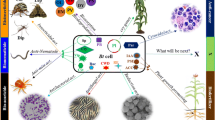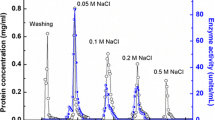Abstract
Nomuraea rileyi (N. rileyi) is the causative agent of the silkworm, Bombyx mori, green muscardine which can cause severe worldwide economical loss in sericulture. Little is known about N. rileyi at the protein level for this entomopathogenic parasite which belongs to the Ascomycota. Here, we employed proteomic-based approach to identify proteins of N. rileyi spores collected from the dead silkworm. In all, 252 proteins were separated by two-dimensional gel electrophoresis (2-DE), and were subjected to mass spectrometry (MS) analysis, 121 proteins have good MS signal, and 24 of them were identified due to unavailability of genomic information from N. rileyi. This data will be helpful in understanding the biochemistry of N. rileyi.

Similar content being viewed by others
References
Boucias DG, Pendland JC (1982) Ultrastructural studies on the fungus, Nomuraea rileyi infecting the velvet bean caterpillar, Anticarsia gemmatalis. J Invertebr Pathol 39:338–345
Charnley AK (1984) Physiological aspects of destructive pathogenesis in insects by fungi: a speculative review. In: Anderson JM, Rayner ADM, Walton DWH (eds) Invertebrate–microbial interactions, British Mycological Society Symposia 6. Cambridge University, London, pp 229–271
Devi UK, Reineke A, Rao UC, Reddy NR, Khan AP (2007) AFLP and single-strand conformation polymorphism studies of recombination in the entomopathogenic fungus Nomuraea rileyi. Mycol Res 111:716–725
El-Sayed GN, Ignoffo CM, Leathers TD, Gupta SC (1993) Cuticular and non-cuticular substrate influence on expression of cuticle-degrading enzymes from conidia of an entomopathogenic fungus, Nomuraea rileyi. Mycopathologia 122:79–87
ESCAP (1990) Handbook on pest and disease control of mulberry and silkworm. Economic and Social Commission for Asia and the Pacific, Bangkok, Thailand
Grinyer J, McKay M, Nevalainen H, Herbert BR (2004) Fungal proteomics: initial mapping of biological control strain Trichoderma harzianum. Curr Genet 45:163–169
Ignoffo CM (1981) Nomuraea rileyi as microbial insecticide. In: Burges HD (ed) Microbial control of pests and plant diseases 1970–1980. Academic Press Inc., London, pp 513–538
Ignoffo CM, Garcia C (1985) Host spectrum and relative virulence of an Ecuadoran and a Mississippian biotype of Nomuraea rileyi. J Invertebr Pathol 45:346–352
Kajiwara H, Ito Y, Imamaki A, Nakamura M, Mita K, Ishizaka M (2005) Protein profile of silkworm midgut of fifth-instar day-3 larvae. J Electrophoresis 49:61–69
Khan A, Williams KL, Soon J, Nevalainen HK (2008) Proteomic analysis of the knob-producing nematode-trapping fungus Monacrosporium lysipagum. Mycol Res (accepted)
Kim Y, Nandakumar MP, Marten MR (2007) Proteome map of Aspergillus nidulans during osmoadaptation. Fungal Genet Biol 44:886–895
Kiuchi M, Yasui H, Hayasaka S, Kamimura M (2003) Entomogenous fungus Nomuraea rileyi inhibits host insect molting by C22-oxidizing inactivation of hemolymph ecdysteroids. Arch Insect Biochem Physiol 52:35–44
Kobori M, Yoshida M, Ohnishi-Kameyama M, Takei T, Shinmoto H (2006) 5α, 8α-Epidioxy-22E-ergosta-6, 9(11), 22-trien-3β-ol from an edible mushroom suppresses growth of HL60 leukemia and HT29 colon adenocarcinoma cells. Biol Pharm Bull 29:755–759
Kumar V, Singh GP, Kumar V, Babu AM, Datta RK (1997) Sem study on the invasion of Nomuraea rileyi (Farlow) on silkworm, Bombyx mori Linn causing green muscardine. Mycopathologia 139:141–144
Li XH, Wu XF, Yue WF, Liu JM, Li GL, Miao YG (2006) Proteomic analysis of the silkworm (Bombyx mori L.) hemolymph during developmental stage. J Proteome Res 5:2809–2814
Yup Lian L (1991) Silkworm diseases. Food and Agriculture Organisation of United Nations, Rome
Liang Y, Chen H, Tang M, Shen S (2007) Proteome analysis of an ectomycorrhizal fungus Boletus edulis under salt shock. Mycol Res 111:939–946
Lim D, Hains P, Walsh B, Bergquist P, Nevalainen H (2001) Proteins associated with the cell envelope of Trichoderma reesei: a proteomic approach. Proteomics 1:899–909
Liu X, Chen K, Yao Q, Li J, Cai K (2008) Proteome analysis of silkworm (Bombyx mori) midgut proteins related to BmNPV infection resistance or susceptibility. Acta Entomol Sin 42:443–448
Long XH, Zhu JW, Mo ZH, Feng S, Cheng G, Zhou XW, Zhang YZ, Yang PY (2006) Development of an effective sample preparation approach for proteomic analysis of silkworm eggs using two-dimensional gel electrophoresis and mass spectrometry. J Chromatogr A 1128:133–137
Lv HS, Jiang YL, Chen XC et al (1990) The sericultural science in China, 2nd edn. Shanghai, China
Mohamed AKA, Nelson FRS (1984) Toxic effect of Nomuraea rileyi extract on Heliothis spp. J Agric Entomol 1:349–353
Mohammed AKA, Sikorowski PO, Bell JV (1978) Histopathology of Nomuraea rileyi in larva of Heliothis zea and in vitro enzymatic activity. J Invertebr Pathol 31:345–352
Onofre SB, Gonzalez RR, Messias CL, Azevedo JL, de Barros NM (2002) LC50 of the peptide produced by the entomopathogenic fungus Nomuraea rileyi (Farlow) Samson active against third instar larvae of Anticarsia gemmatalis (Lep.: Noctuidae). Braz Arch Biol Technol 45:269–275
Pendland JC, Boucias DG (1986) Detection of protease inhibitors in the hemolymph of resistant Anticarsia gemmatalis which are inhibitory to the entomopathogenic fungus, Nomuraea rileyi. Experientia 43:336–339
Pendland JC, Boucias DG (2000) Comparative analysis of the binding of antibodies prepared against the insect Spodoptera exigua and against the mycopathogen Nomuraea rileyi. J Invertebr Pathol 75:107–116
Steinhaus EA (1967) Principles of insect pathology. Hafner Publishing Company, New York, pp 318–416
Sutton RM, Gardner WA, Noblet R (1981) Cellular and humoral responses of fall armyworm larvae to infection by Nomuraea rileyi. J Ga Entomol Soc 16:423–430
Thorvilson HG, Lewis LC, Pedigo LP (1985) Histopathology of Nomuraea rileyi in Plathypena scabra larva. J Invertebr Pathol 45:34–40
Wasti SS, Hartmann GC (1978) Host–parasite interactions between larvae of the gypsy moth, Lymantria dispar (L.) (Lepidoptera: Lymantridae) and the entomogenous fungus, Nomuraea rileyi (Farlow) Samson (Monilials: Moniliaceae). Appl Entomol Zool (Jpn) 13:23–28
Acknowledgments
This study was supported by Grant from the National Basic Research Program of China (No. 2005CB121000), the National “863” project of China (2008AA10Z145) and Jiangsu Sci-Tech Support Project—Agriculture (No. BE2008379).
Author information
Authors and Affiliations
Corresponding author
Rights and permissions
About this article
Cite this article
Qin, L., Liu, X., Li, J. et al. Protein Profile of Nomuraea rileyi Spore Isolated from Infected Silkworm. Curr Microbiol 58, 578–585 (2009). https://doi.org/10.1007/s00284-009-9374-2
Received:
Revised:
Accepted:
Published:
Issue Date:
DOI: https://doi.org/10.1007/s00284-009-9374-2




